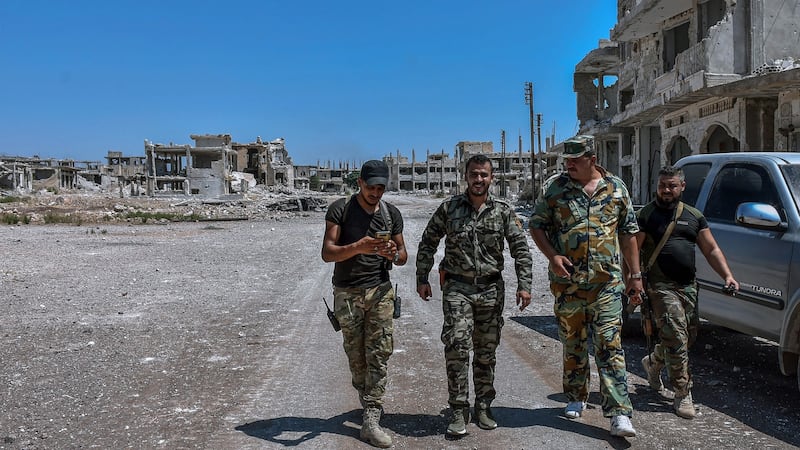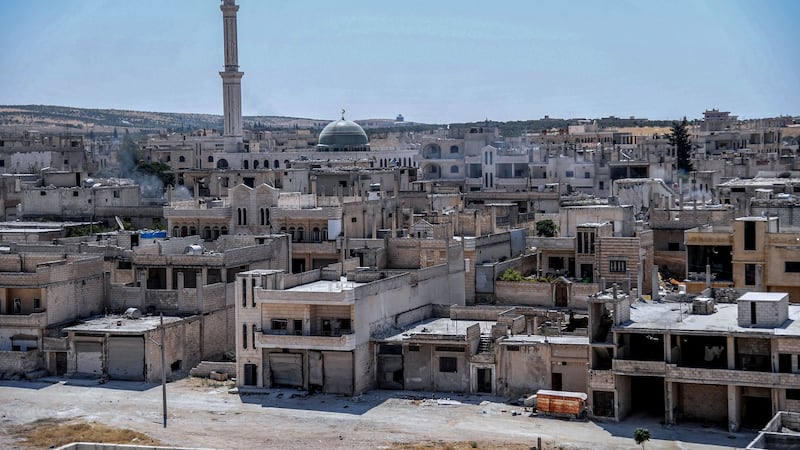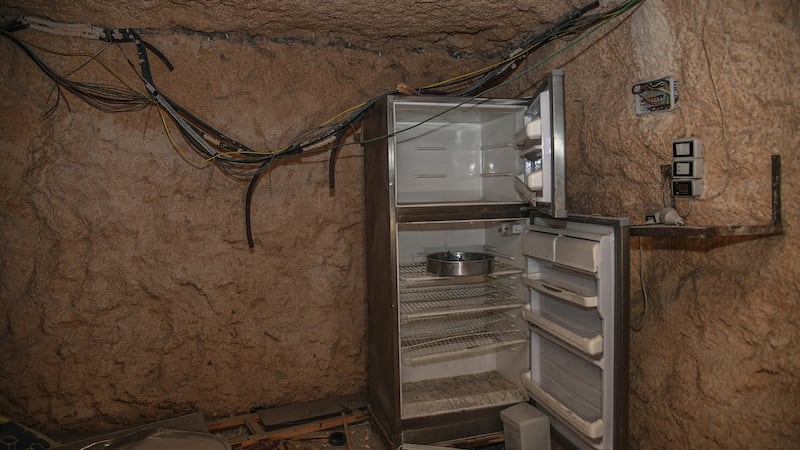All is quiet on the northwestern front. The Syrian army has rolled back jihadis from the edge of Hama, the country's fourth largest city, and taken territory in Idlib province, the last under opposition control. The latest offensive ended with a ceasefire last Saturday morning.
The road from Hama city to the town of Khan Sheikhoun, – objective of the first phase of the army's campaign to retake all of Idlib – is empty but for an occasional motorbike carrying a soldier or two.
Small, craggy pistachio trees spring from the rocky dun-coloured hills on both sides of the route. The trees are untouched by war, neither used for firewood nor burned in a scorched earth insurgent retreat. Their high-priced nuts were harvested and sold in Turkey by jihadis who held this section of northern Hama province until late August, when the Syrian army took control.
Before they withdrew, jihadi forces affiliated with al-Qaeda’s Hay’at Tahrir al-Sham and Turkey’s surrogate Free Syrian Army were “within a kilometre of Hama city”, says my officer guide. “They shelled Hama’s airport and attacked villages [in government controlled territory] with missiles and mortars.”
While northern Hama province is devastated, Hama city has emerged unscathed.
At the battered and deserted village of Mourek, we drive on to an overpass to view the Turkish military position sprawling across a distant hilltop. This is one of a dozen established in Hama and Idlib provinces to monitor the ceasefire and "deconfliction" agreement reached by Turkey and Russia a year ago.
This, however, is not an observation post manned by a few dozen soldiers but a base occupied by 300 troops and enclosed in a cement slab wall with a watchtower. It is now surrounded by the Syrian army although no shots have been fired.
There are seven caves in the territory retaken by the Syrian army
We pause to visit a small dark, dank cave dug beside the road by jihadis as protection from Syrian and Russian air strikes. We use mobile phone lights to view the kitchen and other rooms, including a cell where prisoners were held. There are seven caves in the territory retaken by the Syrian army, which sealed the entrances of the largest in Hbit village. This contains a vast network of tunnels hewed from stone and sheltered hundreds of fighters.



A roadside sign tells us “Hama Thanks You For Your Visit” as we enter Idlib. Khan Sheikhoun is located just across the provincial border. Once the army had taken the approaches to the town, the jihadis withdrew to the north, calling their retreat “redeployment”.
Khan Sheikhoun, named after a 14th century inn, is a strategic town straddling the main Damascus-Aleppo highway. The town, seized by insurgents in 2014, became infamous in 2017 due to a chemical weapons attack blamed on the government.
Khan Sheikhoun had a pre-war population of 35,000; today it is empty of civilians. Their raw concrete block houses have been blasted and crumpled by exploding bombs and stripped of possessions by residents who fled well before the army offensive. Only mosques and minarets have been spared destruction.
About 5km from the front, the area is “lightly held”, to use military parlance. Soldiers, arms out of sight, seek shadowed spaces to escape the brutal sun and stifling heat. A newly established shop sells bottled water and fries crunchy falafel. “An officer was killed here yesterday clearing mines,” says my guide.
We pause at a partially collapsed building which was once an army checkpoint. It was besieged for four months in 2014. A group of soldiers are recovering the buried bodies of 17 killed of the 45 posted there. A survivor identifies remains from two multiple graves.
A wrecked opposition tank and a pile of mortars are abandoned on the roadside
Road signs written in white letters on black signboards read: “Forbidden to shave”: “Women must wear the hijab”; “Democracy is the West’s Religion”; and “Islam is the safe land”. Jihadi flags are gone.
To the west, Hbit village, recaptured by Syria’s army four or five days before Khan Sheikhoun and used as a forward base, is a scene of devastation. A wrecked opposition tank and a pile of mortars are abandoned on the roadside.
In the hilly countryside between Hbit and the village of Kafr Zita we visit a huge, cool cave that had been supplied with water and electricity. A sewing machine lies on the floor near the entrance. The hilltop, empty Abu Obeida village, formerly held by insurgents, overlooks populated government-held Shaizar, dominated by a Crusader fortress .
The Syrian army says it intends to abide by the ceasefire as long as the other side does. This does not mean the government has abandoned its vow to reclaim all of Idlib. The military employs "salami" tactics to achieve this aim – little by little. The objective of the second phase of the army's campaign is the town of Maarat al-Numan on the main highway north of Khan Sheikhoun.
Since August 18th, a 50-vehicle Turkish army column, including tanks, has camped alongside the road between Khan Sheikhoun and Maarat al-Numan with the intention of halting a Syrian army advance. The situation is certain to be discussed on September 16th by Turkey president Recep Tayyip Erdogan and his Russian and Iranian counterparts Valdimir Putin and Hassan Rouhani at their Ankara summit.
If Putin succeeds, this would only postpone the next phase of the Syrian army's campaign to retake Idlib
Putin could press Turkey to meet its commitments in last year’s failed deconfliction agreement to force jihadis to withdraw heavy weapons and fighters from a 15km- to 20km-wide buffer zone around Idlib and halt attacks on the Syrian army and civilians outside the province. If Putin succeeds, this would only postpone the next phase of the Syrian army’s campaign to retake Idlib.
The timing and conduct of phase two of this campaign depends, to a certain extent, on Syria's allies, Russia and Iran. They share interests with opposition-allied Turkey which extend far beyond Syria and the three have separate regional and international agendas.
While the Syrian army received Russian air support from the start of the Khan Sheikhoun offensive on April 30th, Lebanon’s Hizbullah and pro-Iranian Iraqi Shia militias did not join battle until later.
At least 500 people were killed and 400,000 displaced during the first phase of the northwest campaign, where it is estimated at least 30,000 jihadis live among three million civilians.













